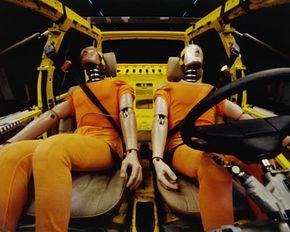Some days, you go into work and just get slammed. For most people, that's just a figure of speech. But for a select few professions, like linebackers, pro wrestlers and crash test dummies, getting slammed is part of the job -- literally.
Advertisement
Now, you're probably thinking it sounds silly to propose that inanimate objects, like crash test dummies, are employed. Before you start screaming for HAL to open the pod bay doors, consider this: Rusty Haight, a living, breathing human being, has completed more than 700 crash tests -- as the dummy. That's right, a human crash dummy.
Crash testing is an integral part of automotive design and engineering, consumer protection and even law enforcement. A number of organizations perform crash tests. Advocacy groups, like Consumer Reports and the Insurance Institute of Highway Safety (IIHS) perform safety and crash tests to protect consumers. The U.S. government performs crash tests to make sure that cars sold in the United States meet minimum safety requirements. Car makers perform crash tests to test how well their cars work. All of these groups use crash tests to find safety issues and test solutions to make cars safer and reduce injuries and deaths from car accidents.
Over the decades, crash test dummies have become remarkable sources of information about the damage that can result from the extreme forces exerted on a body during a violent impact. Read the next page to find out some of the advancements in dummy engineering.
Advertisement



